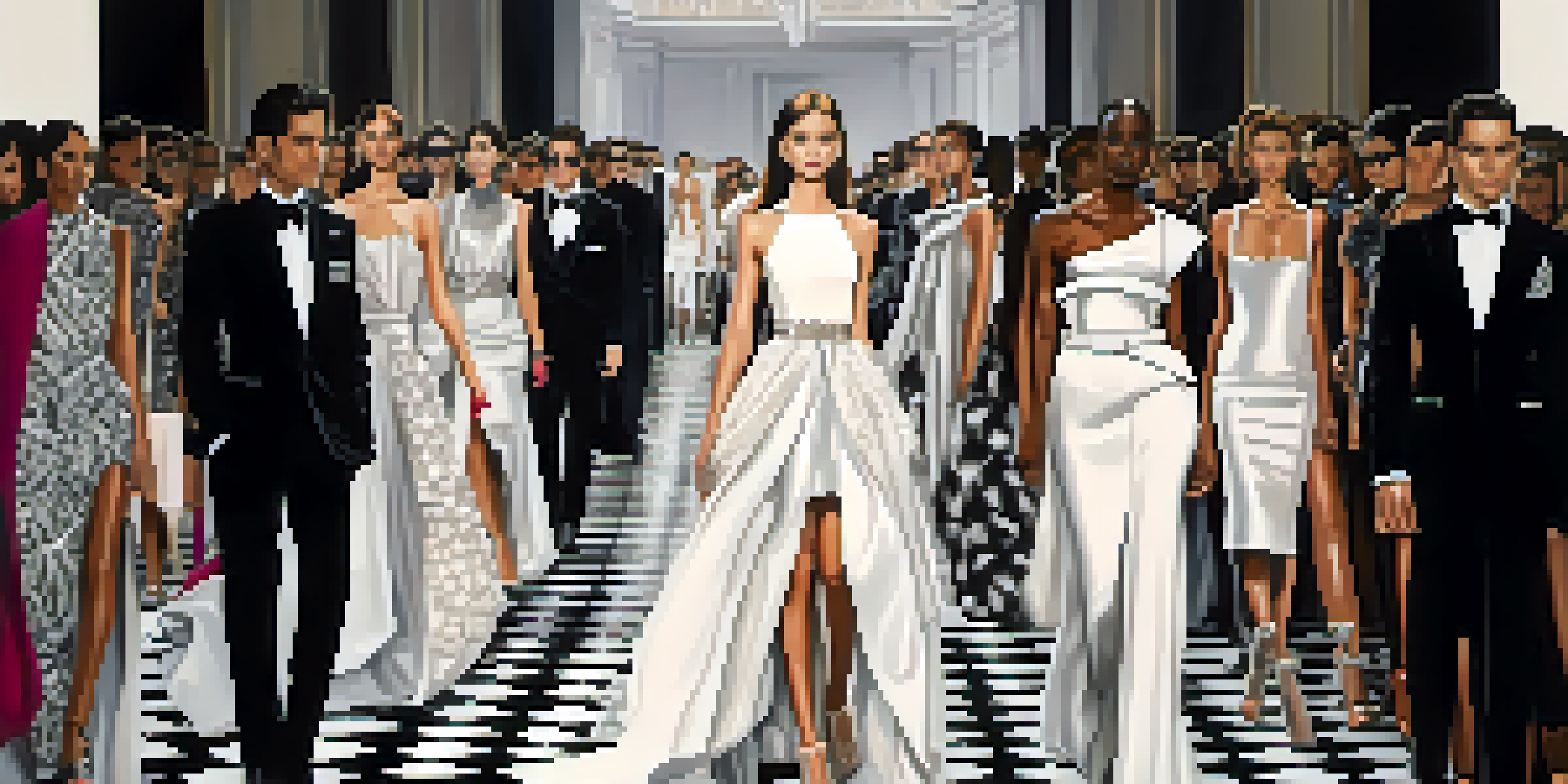The Impact of Karl Lagerfeld on Modern Fashion and Design

Karl Lagerfeld: A Visionary of Fashion Design
Karl Lagerfeld was not just a designer; he was a visionary who transformed the fashion landscape. His unique blend of classic and contemporary styles redefined luxury, making it accessible yet aspirational. Lagerfeld's ability to merge various influences—from historical references to pop culture—set him apart in the industry.
Fashion is about dreaming and making other people dream.
His work with iconic brands like Chanel and Fendi showcased his talent in reviving traditional designs while infusing them with modern flair. This approach not only attracted a younger audience but also revitalized brands that were somewhat stagnant. Lagerfeld's designs were a celebration of creativity, allowing him to leave a profound mark on the fashion world.
Moreover, Lagerfeld's distinct personal style, characterized by his signature sunglasses and white ponytail, became emblematic of his brand. He understood that fashion isn't just about clothing but also about personal expression. This understanding paved the way for future designers to explore their identities through their work.
The Importance of Innovation in Lagerfeld's Work
Innovation was at the heart of Karl Lagerfeld's philosophy. He constantly pushed boundaries, whether through materials, silhouettes, or themes. For instance, his use of digital technology in fashion shows brought an unprecedented level of excitement and engagement, transforming how audiences experienced fashion.

Lagerfeld was not afraid to experiment with new ideas, such as incorporating streetwear elements into high fashion. This bold mixing of styles not only kept his work fresh but also influenced a generation of designers to think outside the box. His innovative spirit paved the way for today's fashion trends that blur the lines between high and low fashion.
Lagerfeld's Vision Transformed Fashion
Karl Lagerfeld redefined luxury by blending classic and contemporary styles, making fashion both accessible and aspirational.
Furthermore, Lagerfeld's knack for storytelling through fashion was revolutionary. Each collection felt like a narrative, captivating audiences and making them part of an artistic journey. This approach helped elevate fashion shows to theatrical experiences, inspiring designers to create immersive presentations.
Cultural Commentary Through Fashion
Lagerfeld's designs often reflected and commented on the cultural zeitgeist. He had a unique ability to tap into societal themes, whether it was feminism, technology, or consumerism. For example, his collections frequently addressed issues like body image and the role of women in society, making his work relevant beyond aesthetics.
What I really like is the transformation, the magic of fashion.
By weaving cultural commentary into his collections, Lagerfeld encouraged fashion lovers to engage with deeper issues. This multidimensional approach not only entertained but also informed, making his designs a conversation starter. His insight into societal trends allowed him to connect with a diverse audience, which was crucial for maintaining brand relevance.
Additionally, Lagerfeld's collaborations with artists and other designers highlighted his commitment to cultural exchange. By blending different artistic visions, he created pieces that resonated with a broader audience, showcasing fashion as a form of art. This intersection of fashion and culture has inspired many contemporary designers to adopt a similar ethos.
Sustainability and Lagerfeld's Legacy
As the fashion industry faces increasing scrutiny over sustainability, Lagerfeld's legacy becomes even more significant. While some might argue his fast-fashion approach conflicted with sustainable practices, he did advocate for quality and craftsmanship in his work. This emphasis on timeless design encourages consumers to invest in pieces that last, rather than fleeting trends.
Lagerfeld's focus on creating high-quality garments can inspire modern designers to prioritize sustainability. By emphasizing craftsmanship, designers can produce collections that are not only beautiful but also environmentally conscious. This shift in focus is crucial as the industry transitions toward more sustainable practices.
Innovation at the Core of Design
His fearless experimentation with materials and themes, including digital technology and streetwear, influenced a generation of designers.
Moreover, Lagerfeld's ability to adapt and evolve his designs could serve as a blueprint for future fashion leaders. His willingness to embrace change while maintaining a commitment to quality can guide the industry's efforts to balance innovation with responsibility. In this way, Lagerfeld's influence extends far beyond his lifetime.
The Role of Technology in Fashion Evolution
Karl Lagerfeld was a pioneer in integrating technology into fashion. He understood the potential of digital platforms to reach a global audience, becoming one of the first designers to utilize social media for marketing. This forward-thinking approach transformed how fashion brands engage with consumers, setting a precedent for future marketing strategies.
His innovative use of technology extended to fashion shows, where he incorporated live-streaming and digital presentations. This not only broadened accessibility but also changed the way collections were perceived and discussed online. By embracing technology, Lagerfeld opened doors for designers to interact with a wider audience in real-time.
Furthermore, Lagerfeld's collaborations with tech companies showcased his vision for the future of fashion. By merging fashion with technology, he inspired a new wave of designers to explore the possibilities of wearable tech and smart clothing. This integration of technology into fashion is a trend that continues to grow, echoing his legacy.
Lagerfeld's Influence on Fashion Education
Karl Lagerfeld's work has had a profound impact on fashion education, inspiring countless students and aspiring designers. His emphasis on creativity and innovation encourages young designers to push boundaries and explore their artistic visions. This spirit of experimentation is essential in cultivating the next generation of fashion leaders.
Many fashion schools now study Lagerfeld's career as a case study in versatility and adaptability. His ability to navigate various roles—from designer to photographer to artist—demonstrates the importance of being multifaceted in today's fashion landscape. This holistic approach to fashion education prepares students to thrive in an ever-evolving industry.
Cultural Commentary in Fashion
Lagerfeld's designs addressed societal themes, encouraging deeper engagement with issues like feminism and body image, making his work relevant beyond aesthetics.
Moreover, Lagerfeld's legacy encourages students to engage with cultural and societal issues through their work. By understanding the historical context of fashion, they can create pieces that resonate with contemporary audiences. This connection between past and present is vital for fostering meaningful discussions within the industry.
The Enduring Legacy of Karl Lagerfeld
Karl Lagerfeld's impact on modern fashion is undeniable and will continue to influence the industry for years to come. His unique blend of creativity, innovation, and cultural relevance has set a standard for designers everywhere. As the fashion world evolves, Lagerfeld's legacy serves as a reminder of the power of vision and artistry.
The principles he championed—timeless design, cultural engagement, and technological integration—remain crucial for contemporary designers. By embracing these ideals, the fashion industry can continue to grow while honoring Lagerfeld's contributions. His influence is a guiding light for those looking to carve their paths in fashion.

Ultimately, Lagerfeld's ability to blend style with substance has left an indelible mark on fashion history. As we celebrate his life and work, it's essential to recognize the lessons he imparted: the importance of innovation, the relevance of cultural commentary, and the enduring power of fashion as a form of self-expression.